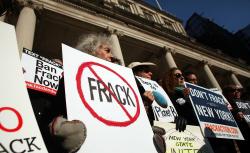On Monday, ProPublica is hosting a live discussion at New York City’s Tenement Museum on “The Perils and Promise” of using hydraulic fracturing to drill for natural gas. To get the conversation going, here is a collection of can’t-miss watchdog journalism on fracking.
Halliburton’s Interests Assisted by the White House, Los Angeles Times, October 2004
Despite environmental concerns raised by staff members at the EPA George W. Bush and Dick Cheney firmly supported hydraulic fracturing—a technique that just happened to be developed by Halliburton, a company Cheney headed from 1995 to 2000.
Buried Secrets: Is Natural Gas Drilling Endangering U.S. Water Supplies?, ProPublica, November 2008
Though a 2004 EPA study found fracking did not pose a risk to drinking water, contamination was far more prevalent than indicated in the report. A case in rural Wyoming was the first recognized by a federal agency. But more than 1,000 other cases tied to drilling and francking have been documented by courts and state and local governments, including one that blew up a house.
State Oil and Gas Regulators Are Spread Too Thin To Do Their Jobs, ProPublica, December 2009
As fracking operations ballooned in 22 states, regulators struggled to keep up. Questions about resources required to regulate fracking rarely entered the debate, but it was hard to ignore in a place like Texas, where the number of new wells drilled each year jumped 75 percent from 2003 to 2009 while state regulatory staff increased just 5 percent.
Game Changer, This American Life, July 2011
One Pennsylvania professor discovers that fracking is an economic boon; another, that the technique is an environmental nightmare. Politics ensue, and the resulting story provides poignant insight into what happens when a game-changer hits a state, “like natural gas hit Pennsylvania.”
Fracking at Drinking Water Source for 80,000 Pennsylvanians Raises Alarms, Inside Climate News, July 2011
When one Pennsylvania water utility leased its watershed to gas drillers without much public input, residents, even those not totally opposed to fracking, became concerned. Though this watershed was the only one to have leased its land, many others were being courted.
A Tainted Water Well, and Concern There May Be More, New York Times, August 2011
For decades, oil and gas industry executives claimed that fracking never contaminated underground drinking water. Except one EPA report documented just such a case—and it was published in 1987. The same report suggested that more cases may exist, but sealed settlements between energy companies and landowners prevented researchers from investigating further
Hunt for Gas Hits Fragile Soil, and South Africans Fear Risks, New York Times, December 2011More than 30 countries are now considering fracking for natural gas or oil, and the U.S. has “taken a lead role in supporting the dissemination of the technique abroad.” In some countries, especially in developing nations, it’s often been adopted with a “drill-first, figure-out-regulations-later attitude” that could lead to problems.
How the Sierra Club Took Millions from the Natural Gas Industry and Why They Stopped, Time, February 2012
Some environmental groups initially promoted natural gas as a “bridge fuel,” because of its smaller carbon footprint. But the Sierra Club’s cozy relationship with the industry blew up on them after concerns about pollution from fracking moved to the forefront. This article traces big environmental groups’ attempts to change the energy industry “from within” — and the tension that led to with grassroots supporters.
For Pennsylvania’s Doctors, a Gag Order on Fracking Chemicals, Mother Jones, March 2012
A new law lets Pennsylvania doctors can request information about fracking chemicals. They just can’t share it with anyone—including their patients.
(ProPublica reporter Abrahm Lustgarten helped curate this list.)
